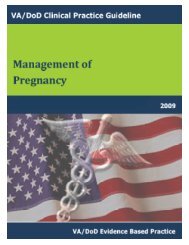DM Full Guideline (2010) - VA/DoD Clinical Practice Guidelines Home
DM Full Guideline (2010) - VA/DoD Clinical Practice Guidelines Home
DM Full Guideline (2010) - VA/DoD Clinical Practice Guidelines Home
You also want an ePaper? Increase the reach of your titles
YUMPU automatically turns print PDFs into web optimized ePapers that Google loves.
Version 4.0<br />
K. Provide Local Wound Care; Offload Pressure and Weight, As Indicated<br />
OBJECTIVE<br />
Provide care of an uncomplicated minor lesion.<br />
RECOMMENDATIONS<br />
<strong>VA</strong>/<strong>DoD</strong> <strong>Clinical</strong> <strong>Practice</strong> <strong>Guideline</strong><br />
for the Management of Diabetes Mellitus<br />
1. Patients with diabetes with uncomplicated minor lesions should receive local wound care. Primary care<br />
providers should attempt to offload weight-bearing on the affected extremity.<br />
2. Patients with diabetes with uncomplicated minor lesions must be followed at least monthly.<br />
DISCUSSION<br />
The following are simple guidelines for the care of uncomplicated minor lesions:<br />
• Provide local wound care: cleanse wound with saline, remove necrotic and callus tissue, apply appropriate<br />
dressing, and other indicated treatments.<br />
• Offload pressure and weight, as indicated: consider lesion site and then provide pressure relief (e.g.,<br />
special shoes and insoles and bed rest). To avoid further trauma to the lesion site, use a post-operative<br />
shoe, offloading, or depressurization footwear based on the lesion site(s).<br />
• Follow-up on a specified schedule: <strong>VA</strong> facility specific patients with active lesions need to be followed at<br />
least monthly.<br />
• Review the Self-Management and Education Module (Module S): reinforce nutrition, exercise and diabetes<br />
self-management. Avoid initiation of a calorie restriction diet for weight loss in patients with foot lesions.<br />
• Provide patient and family education.<br />
• Refer for foot care assistance, as needed, for patients unable to carry-out local wound care. Educate a<br />
family member on local wound care or refer the patient to a home health service.<br />
EVIDENCE<br />
Recommendation Sources LE QE SR<br />
1 Local wound care. ADA, 2000<br />
III Poor I<br />
Brodsky, 1991<br />
Caputo et al., 1994<br />
Eckman et al., 1995<br />
LE-Level of Evidence; QE = Quality of Evidence; SR = Strength of Recommendation (see Appendix A).<br />
L. Has Wound Healed Within 4 Weeks?<br />
OBJECTIVE<br />
Determine appropriateness of the treatment outcome.<br />
RECOMMENDATIONS<br />
1. Patients with diabetes treated for an uncomplicated wound should be assessed within four weeks from the<br />
initial wound assessment for appropriate reduction in lesion size and depth and appearance of healthy<br />
granulating tissue with no evidence of infection.<br />
EVIDENCE<br />
Recommendation Sources LE QE SR<br />
1 Assessment of wound healing<br />
progress within 4 weeks.<br />
ADA, 2000 III Poor I<br />
LE-Level of Evidence; QE = Quality of Evidence; SR = Strength of Recommendation (see Appendix A).<br />
Module F – Foot Care Page 104
















